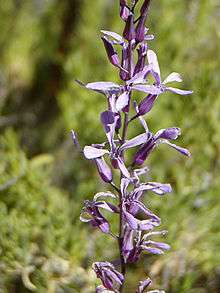Thelypodium howellii
| Thelypodium howellii | |
|---|---|
 | |
| Thelypodium howellii spectabilis | |
| Scientific classification | |
| Kingdom: | Plantae |
| (unranked): | Angiosperms |
| (unranked): | Eudicots |
| (unranked): | Rosids |
| Order: | Brassicales |
| Family: | Brassicaceae |
| Genus: | Thelypodium |
| Species: | T. howellii |
| Binomial name | |
| Thelypodium howellii S. Wats. | |
Thelypodium howellii, the Howell's thelypody[1] or Howell's thelypodium, is a rare plant of the Western United States. It is endemic to a relatively small area on the borders of three western States: Oregon, Nevada, and California.
Description
The Thelypodium howellii plant is biennial. It is often somewhat hairy, especially near the base, but may be hairless and waxy in texture. It produces a slender, branching, erect stem up to 70 centimeters tall. The leaves are mostly located in a rosette around the base. Leaves located higher on the stem may have clasping bases.
The inflorescence is a raceme of widely spaced flowers with greenish white or purplish sepals and pale blue or purple, spoon-shaped petals. The fruit is a silique up to 4.5 centimeters long containing plump brown seeds.[2][3][4][5][6]
hi
Distribution, habitat, and ecology
This plant is endemic to a small area stretching from north-eastern Oregon to north-eastern California.[6] It lives in alkaline or adobe meadows and seeps, river valleys and moist plains in Great Basin sagebrush scrub.[2] The fire ecology of this plant is not known at present.
Conservation status and threats
U.S. Forest Service Pacific Southwest Region Sensitive Species.
California Native Plant Society List 1B.2.
NatureServe California State Rank: S2.2; Global Rank: G2
The threats facing Howell's thelypody are not known at present.
Field identification
Howell's thelypody flowers from May to July. Var. spectabilis, known only from Malheur Co., Oregon, is larger than var. howellii, has larger, more strongly purple flowers, and is a federally listed species.[6]
References
- ↑ "Thelypodium howellii". Natural Resources Conservation Service PLANTS Database. USDA. Retrieved 9 December 2015.
- 1 2 "Howell's Thelypodium". Eagle Lake Field Office. U.S. Department of Interior, Bureau of Land Management. Archived from the original on 2007-06-14. Retrieved 2007-05-01.
- ↑ Payson, Edwin Blake (1922). "Study of Thelypodium and its Immediate Allies". Annals of the Missouri Botanical Garden. 9 (3): 265–266. doi:10.2307/2990054.
- ↑ Schofield, W.B. (2002). Field Guide to the Liverwort Genera of Pacific North America. University of Washington Press. p. 181.
- ↑ Rollins, Reed C. (1993). Hickman, James C., ed. The Jepson Manual: Higher Plants of California. University of California Press. pp. 444–446.
- 1 2 3 Hitchcock, C. Leo; Arthur Cronquist; Marion Ownbey; J. W. Thompson (1964). Vascular Plants of the Pacific Northwest, Part 2: Salicaceae to Saxifragaceae. University of Washington Press. p. 549.
External links
| Wikispecies has information related to: Thelypodium howellii |
